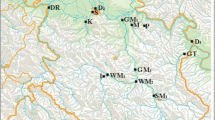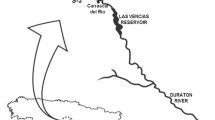Abstract
The Ok Tedi copper mine currently discharges overburden and partially treated ore residues into the Ok Tedi, a major tributary of the Fly River. At peak production these discharges will result in an increase in the suspended solids levels in the Fly River from a background of 76 mg L-1 to approximately 800 mg L-1, and an increase in median particulate copper levels from 90 μg g-1 to 1220 μg g-1. The dissolved copper levels are not expected to exceed 10 μg L-1. The Strickland River, a tributary of the Fly River, has natural suspended solids levels in excess of 500 mg L-1 and provided a natural bioassay for the impacts of elevated suspended solids levels. The fish communities of the Strickland River were dominated by the sediment-tolerant Ariidae catfish, but the levels of biomass caught per standard sampling effort were comparable to those in the Fly River. Laboratory bioassays were performed to assess the impact of particulate associated copper. The fish fauna of the Fly River does not include any standard test species, and it is unlikely that standard species would be unaffected by the high suspended solids levels of the Fly River. Test species were selected on the basis of ecological importance. Two freshwater prawns,Macrobrachium rosenbergii andMacrobrachium sp., a catfish,Neosilurus ater, and a cladoceran,Ceriodaphnia dubia, were tested for acute toxicity and bioaccumulation of copper from particulates. There was no evidence of acute toxicity to prawns or fish, nor for bioaccumulation by prawns. Acute toxicity toC. dubia and bioaccumulation byN. ater were probably due to dissolved copper in the test environments. The test results indicated that provided dissolved copper levels did not exceed the predicted levels, there should not be toxic affects of particulate-associated copper in the Fly River.
Similar content being viewed by others
References
Alabaster, J. S. and Lloyd, R.: 1982, ‘Water Quality Criteria for Freshwater Fish’, Butterworth Scientific, London.
Biesinger, K. E. and Christensen, G. M.: 1972, ‘Effects of Various Metals on Survival, Growth, Reproduction, and Metabolism ofDaphnia magna’,J. Fish. Res. Bd. Canada 29, 1691–1700.
Coates, D.: 1985, ‘Fish Yield Estimates for the Sepik River, Papua New Guinea, a Large Floodplain System East of ‘Wallace's Line’’,J. Fish Biol. 27, 431–443.
Hortle, K. G.: 1986, ‘A Review of Biological Sampling of the Ok Tedi and Fly River Systems, April 1983 to June 1986’, Ok Tedi Mining Limited, Report No. ENV 86-09.
Hortle, K. G.: 1987a, ‘Six-Monthly Biology Review, 1 July to 09 April 1987’, Ok Tedi Mining Limited, Report No. ENV 87-08.
Hortle, K. G.: 1987b, ‘Studies of the Benthic Fauna of Lowland (Potamon) Localities of the Ok Tedi and Fly River, with Reference to Mining Impacts’, Ok Tedi Mining Limited, Report No. ENV 87-11.
Le Blanc, G. A.: 1982, ‘Laboratory Investigation into the Development of Resistance ofDaphnia magna (Straus) to Environmental Pollutants’,Environ. Pollut. (Series A) 27, 309–322.
Le Blanc, G. A.: 1985, ‘Effects of Copper on the Competitive Interactions of Two Species of Cladocera’,Environ. Pollut. (Series A) 37, 13–25.
Merrick, J. R. and G. Schmida: 1984, ‘Australian Freshwater Fishes: Biology and Management’, Griffin Press Limited, Netley, South Australia.
Ok Tedi Mining Limited: 1988, ‘Sixth Supplemental Agreement Environmental Study Progress Report No. 3’, Ok Tedi Mining Limited, Report No. ENV 88-06.
Roberts, T. R.: 1978, ‘An Icthyological Survey of the Fly River in Papua New Guinea, with Descriptions of Nex Species’,Smiths. Contrib. Zool. 281, 1–72.
Salomans, W.: 1984, ‘Review of the Environmental Impact of Mining Operations on the Ok Tedi/Fly River System. Part II: Main Report’, Delft Hydraulics Laboratory, Delft.
Smith, R. E. W.: 1987, ‘Six Monthly Biology Review, 10 April to 10 October 1987’, Ok Tedi Mining Limited, Report No. ENV 87-14.
Smith, R. E. W.: 1988, ‘Six Monthly Biology Review, 11 October 1987 to 30 March 1988’, Ok Tedi Mining Limited, Report No. ENV 88-05.
Welcomme, R. L.: 1985, ‘River Fisheries’,F.A.O. Fish. Tech. Pap. No 262.
Winner, R. W.: 1985, ‘Bioaccumulation and Toxicity of Copper as Affected by Interactions Between Humic Acid and Water Hardness’,Water Res. 19, 449–455.
Author information
Authors and Affiliations
Rights and permissions
About this article
Cite this article
Smith, R.E.W., Ahsanullah, M. & Batley, G.E. Investigations of the impact of effluent from the Ok Tedi copper mine on the fisheries resource in the Fly River, papua new guinea. Environ Monit Assess 14, 315–331 (1990). https://doi.org/10.1007/BF00677924
Issue Date:
DOI: https://doi.org/10.1007/BF00677924




